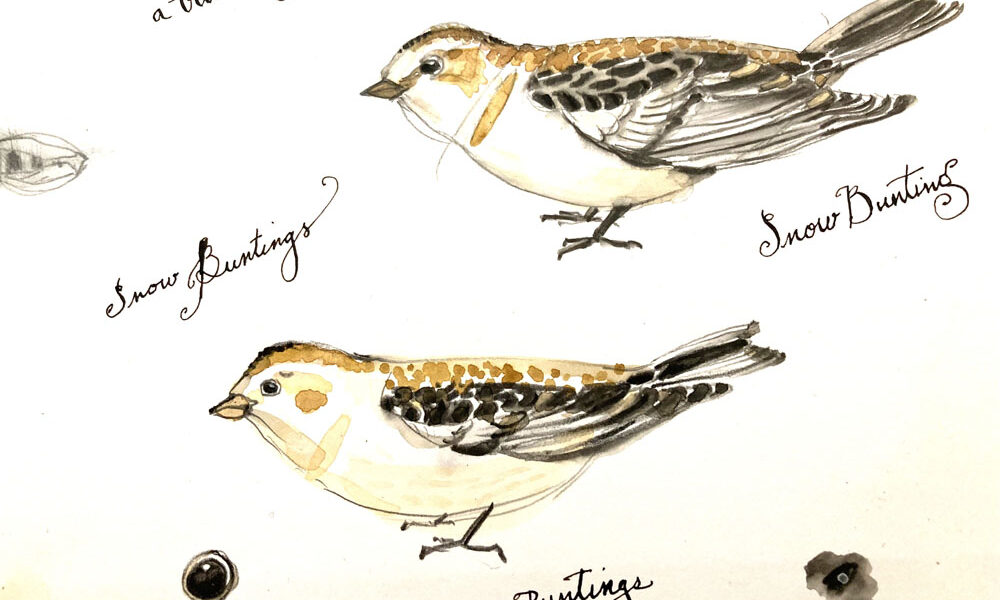Trail Time – Snow has arrived!
We finally have significant snowfall on the Gunflint Trial, which is very welcome after last year’s nearly brown winter. The first snow came a couple weeks ago. The big snowflakes floated down from the sky in a gentle diagonal flight patterns. The smallest change of air movement made the snowflakes pause, swirl, and then fall upward in the most delightful way. That snow didn’t stick around and I admit I got a little moody about it. I hate winter without snow.
The second snow came shortly after and decided to stay. The third wave of snow hasn’t stopped for over a week. Twelve inches have fallen, though it looks like less on the ground. The snow flurries come and go and never really stop for long. Our world is a snow globe that you don’t need to shake. The wind is doing that job now, whipping up every loose bit of snow until the sun — when you see it at all — glows like the moon through the low gray swiftly moving clouds.
As wave after wave of flurries pass, occasionally the sky clears for a moment and the open water of the lake reflects back a deep steelly blue. Then from the west, another snow squall approaches, veiling the far shore of the lake with a white shroud. The surface of the lake takes on a forbidding hue, like a gray northern sea.
When I was out wandering last week, I discovered a red elderberry bush with plump purple buds. I love plants that bud in the winter — it’s so hopeful. And the fact that anything can create that color is a minor miracle. Elderberries are a food source for many animals and birds, and the elderflowers are important to pollinators. Parts of the plant are poisonous to humans, so do your research and use caution. The red elderberry shrub can be identified in the winter by its warty-looking marks on the bark. Those are called lenticels. If you cut a branch, it reveals a spongy brown center called pith. That’s spelled P I T H. The older woodier branches from lower on the shrub are hollow and can be used to make flutes. One Ojibwe name for elderberry is Bibigwemin. When you say “Bibigwe migizi,” it means a bald eagle makes fluting sounds.
It is exhilarating, to be sure, to be out and about in this wild winter weather but it’s like camping — one of those things that are hard but simple. Preparation is key. I’ve spent many years accumulating clothing — especially boots — for most weather conditions. That’s why it looks like there are eight people living here instead of two, but man, we are ready! Getting dressed to go outside in the winter can tax one’s patience — add 20 minutes to each outing in order to put on your gear. From toes to top here it is, my usual gear for a day of 9 degrees above that feels like 14 below due to wind chill:
socks
boots
overboots
leggings
insulated pants
shirt
wool sweater or fleece top and maybe a quilted vest
anorak with fur-lined hood
heat reflective thin gloves with leather choppers (mittens) or thick mittens with windproof outer mittens
a hat or two…
And you’re set, but inevitably, nature calls just as you are sliding the second mitten on before you open the door to go out. Weigh your options carefully.
A walk in the winter can give rise to existential questions if you are not careful: Why is life a struggle? Is struggle good for humans? Do the animals struggle? Some of them that are popularly considered stupid have brilliant winter strategies; I have in mind the ruffed grouse and the beautiful snow homes they make under the drifts.
Other birds make winter life look easy. But maybe birds have a Jedi mindset and, like ants, there exists only Do or Not Do. The snow buntings don’t let us in on their struggle, if that is truly their reality. They are such happy-making birds. I went on a memorable walk with a snow bunting once; we kept a companionable but proper distance between us. Birds have formal manners, or at least strict rules on social interactions. Sometimes the snow buntings travel in great numbers. One day I was driving down the Trail when buntings flew up from the road in such a dense flock that my smartish car, overthinking the situation, put its brakes on. By itself. The snow buntings come and go in our part of the world, according to secret information they have about the weather. I wish they would stay put longer. They are such lovely birds.
We have our year-round resident birds to keep us company when the snow buntings are out on a mission: chickadees, nuthatches, gray and blue jays, redpolls, hairy and downy woodpeckers. It’s a thrill to see the Crossbills and Grosbeaks, especially that tropically colored bird, the evening grosbeak. The junco population waxes and wanes year by year. And the ravens…the ravens are alway with us, calling out to warn other beings of our presence, playing in the air, sailing through the sky, delivering our prayers to heaven.
— Marcia Roepke on the Gunflint Trail











